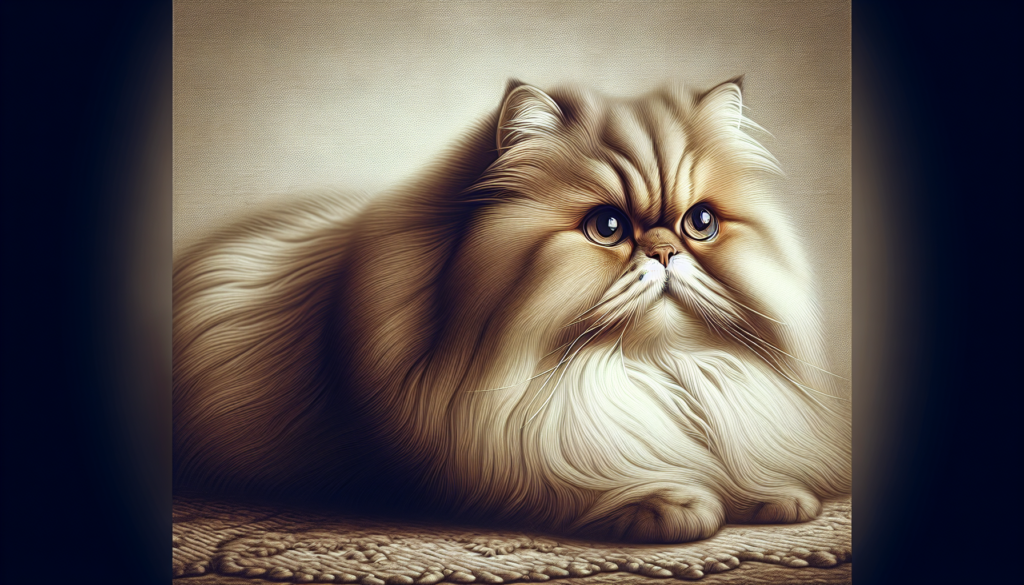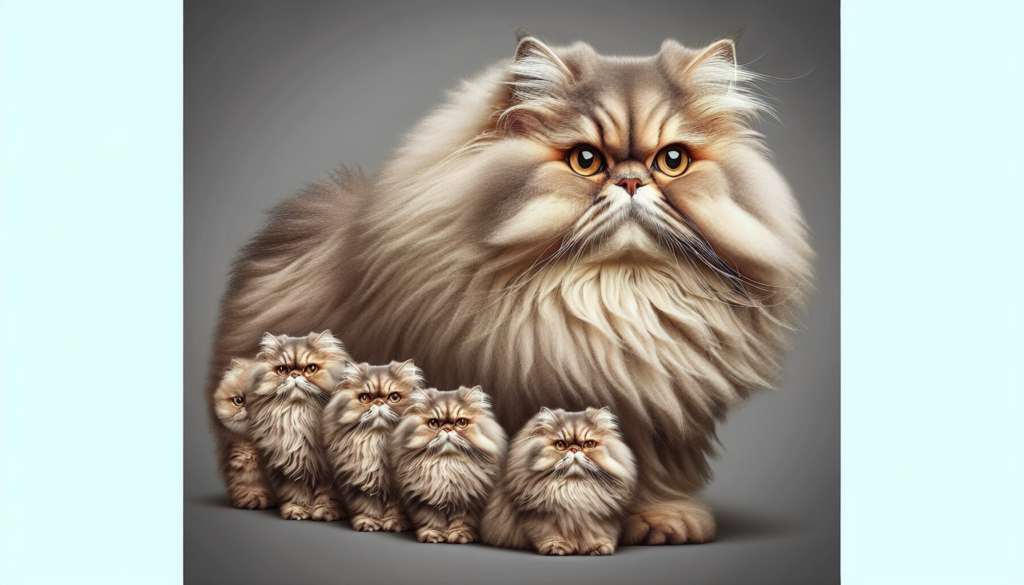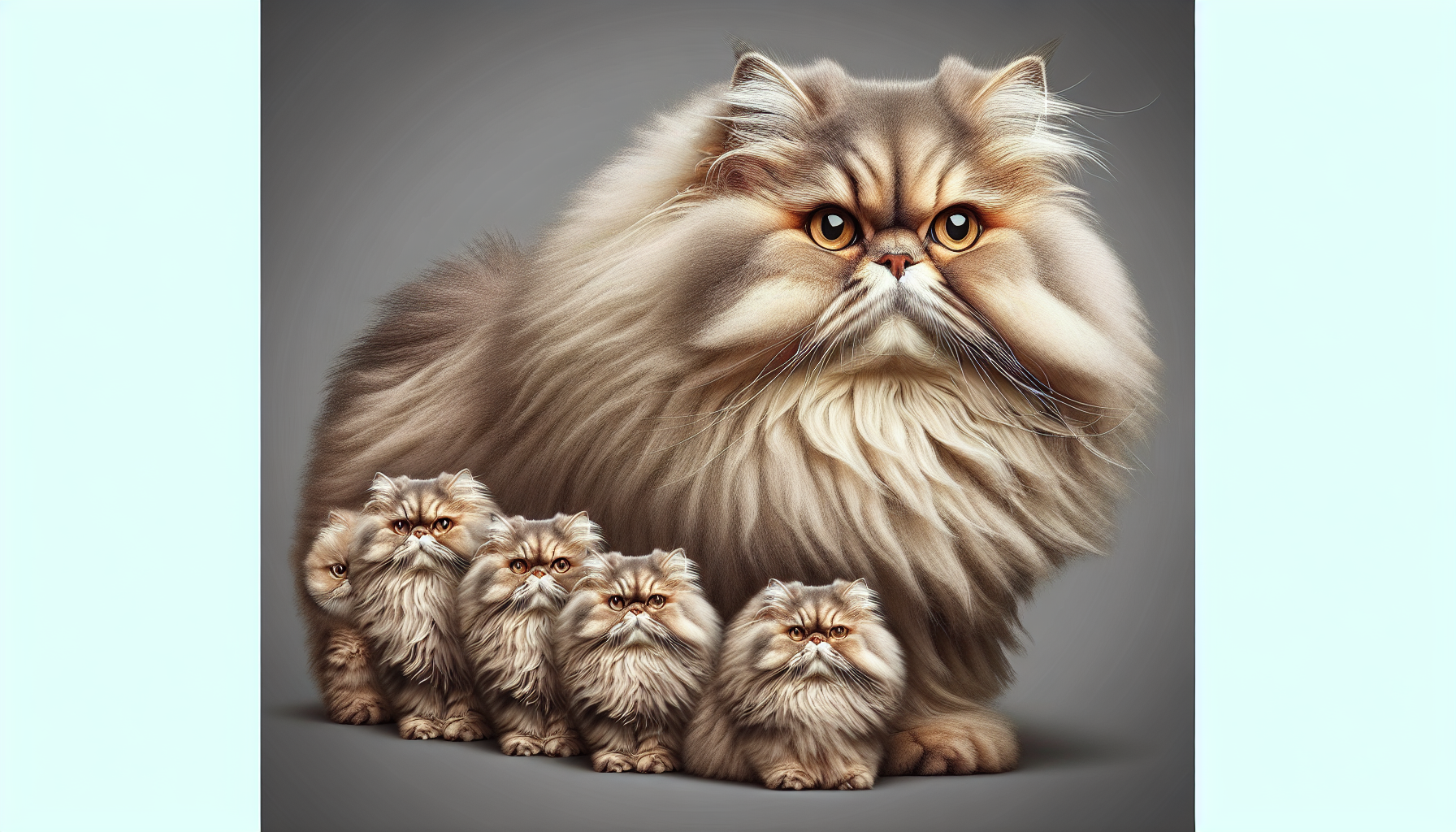Are you curious about the potential size of Persian cats? Wonder no more! In this article, we will explore the question of “How Big Do Persians Get?” Persian cats are known for their majestic and luxurious coats, but their size is equally impressive. From their fluffy tails to their plump bodies, Persian cats can grow to be quite large and substantial. So, let’s delve into the details and discover just how big these adorable felines can become.

Physical Characteristics of Persians
Body Size
Persians are known for their large and robust body size. As one of the largest domestic cat breeds, they typically have a substantial body structure. Adult Persians can reach an impressive size, with males typically weighing between 9 to 14 pounds (4 to 6 kilograms), and females weighing slightly less at 7 to 11 pounds (3 to 5 kilograms). Their size is one of the defining features that make them stand out among other breeds.
Body Shape
Persians have a distinct body shape that is characterized by their rounded and broad chest, giving them a solid and muscular appearance. They have a short and strong neck, which supports their well-developed head. Their body shape is considered cobby, meaning they have a compact and sturdy build. This contributes to their overall regal and majestic presence.
Weight Range
The weight range of Persians can vary depending on factors such as genetics, nutrition, and overall health. While the average weight of males ranges from 9 to 14 pounds, and females from 7 to 11 pounds, it’s important to note that individual cats may fall outside of this range. Some Persians may naturally be smaller or larger than the average, but as long as they are healthy and well-proportioned, their weight should not be a cause for concern.
Facial Features
One of the most recognizable and endearing features of Persians is their adorable flat face, also known as brachycephalic. Their face is characterized by a short nose and a rounded skull, which gives them a unique and charming appearance. Their large and expressive eyes, set wide apart, further enhance their gorgeous facial features. The combination of their captivating eyes and flat face contributes to their overall appeal and has made them a popular breed among cat enthusiasts.
Factors Affecting the Size
Genetics
Genetics play a significant role in determining the size of Persian cats. The genes inherited from their parents can heavily influence their growth patterns and body size. Breeders carefully select parental cats with desirable size traits to produce litters that are more likely to develop into large-sized Persians. It’s important to note that genetics alone cannot solely determine the size of a Persian cat, as environmental factors such as nutrition and health also play a crucial role.
Nutrition
Proper nutrition from a young age is crucial for the healthy growth and development of Persians. A well-balanced and nutritious diet is essential to ensure their bones, muscles, and overall body size develop optimally. Feeding them high-quality cat food, specifically formulated for their needs, can help maintain their ideal weight and promote healthy growth. Monitoring their food intake and providing them with appropriate portion sizes can help prevent overfeeding, as excessive weight gain can negatively impact their overall health and mobility.
Health Conditions
Certain health conditions can affect the size of Persian cats. While genetics and nutrition are major contributors, it’s essential to consider possible underlying health issues that may hinder their growth. Conditions such as hormonal imbalances, metabolic disorders, or malnutrition can impact their size and development. Regular veterinary check-ups are important to monitor their overall health and address any potential concerns early on.
Growth and Development
Kitten Stage
During the kitten stage, Persians experience rapid growth and development. They are incredibly tiny and delicate when they are first born, weighing only a few ounces. However, as they grow, they quickly start gaining weight and developing their sturdy body structure. With proper nutrition, care, and a nurturing environment, Persians thrive and progress through their kitten stage, gradually transitioning into the adolescent phase.
Adolescent Stage
As Persians enter their adolescent stage, their growth rate starts to slow down, but they continue to gain size and develop their adult features. This is when their body shape becomes more apparent, and their bones and muscles strengthen. Good nutrition, regular exercise, and mental stimulation are essential during this stage to support their growth and promote their overall well-being as they mature into adulthood.
Adult Stage
The adult stage is when Persians reach their full physical size and maturity. Most Persians achieve their maximum size between 1 to 2 years of age, although some may continue to fill out and develop until they are around 3 years old. At this stage, their body shape is fully developed, and they exhibit the characteristic cobby build. It’s important to maintain a healthy lifestyle and regularly monitor their weight to ensure proper weight management and overall health.
Senior Stage
As Persians enter their golden years, they may experience changes in their size and overall health. Like all living beings, their bodies naturally go through the aging process. Some Persians may start losing weight and muscle mass, while others may experience weight gain due to reduced activity levels. Regular veterinary care and monitoring of their weight and health are crucial at this stage to ensure their comfort, mobility, and overall well-being.
Size Comparison with Other Breeds
Persian vs. Maine Coon
When comparing the size of Persians to Maine Coons, both breeds are known for their impressive size, but Maine Coons tend to be larger overall. Maine Coons are considered one of the largest domestic cat breeds, with males weighing between 13 to 18 pounds (6 to 8 kilograms), and females ranging from 8 to 12 pounds (4 to 6 kilograms). While Persians may fall slightly short in terms of size, their sturdy build and regal appearance make them equally captivating.
Persian vs. Ragdoll
Ragdolls are another breed known for their larger size, often compared to Persians. Ragdolls typically have a more substantial body structure and can outweigh Persians. Male Ragdolls can range from 15 to 20 pounds (7 to 9 kilograms), while females generally weigh between 10 to 15 pounds (4 to 7 kilograms). Despite being slightly smaller, Persians showcase their elegance and grace in their own unique way.
Persian vs. British Shorthair
When comparing Persians to British Shorthairs, the size difference is notable. British Shorthairs have a more rounded and stocky body shape compared to Persians, but they are not as large overall. Male British Shorthairs usually weigh between 9 to 17 pounds (4 to 8 kilograms), while females tend to weigh slightly less at 7 to 12 pounds (3 to 6 kilograms). Both breeds have their own distinct charm and allure, attracting cat lovers worldwide.
Persian vs. Siamese
Siamese cats are generally smaller in size compared to Persians. They have a more slender and lithe body structure, which sets them apart from the cobby build of Persians. Male Siamese cats usually weigh between 8 to 12 pounds (4 to 6 kilograms), and females range from 5 to 8 pounds (2 to 4 kilograms). While Persians may surpass Siamese cats in terms of size, both breeds offer their own unique personality traits and characteristics that make them beloved companions.

Caring for a Large Persian
Proper Nutrition
Maintaining a healthy and balanced diet is crucial for the well-being of large Persians. Providing them with high-quality cat food that is appropriate for their age, size, and overall health is essential. Choosing a diet that is rich in nutrients, such as protein and essential vitamins, supports their growth, muscle development, and energy levels. It’s important to monitor their food intake and ensure proper portion sizes to prevent overeating and weight gain.
Exercise and Activity
While Persians may not be as naturally active as some other breeds, regular exercise and activity are still essential for maintaining their overall health and preventing weight-related issues. Engaging them in interactive play sessions with toys or providing them with scratching posts and climbing trees can help promote physical activity and mental stimulation. Gentle exercise, such as short walks or supervised outdoor time in safe environments, can also be beneficial.
Grooming Needs
Persians are famous for their luxurious long coat, but it requires regular grooming to keep it looking its best. Brushing their fur daily helps prevent matting and tangling, as well as reduces shedding and hairballs. Paying attention to their hygiene is important, especially around facial folds and eyes, to prevent any buildup of dirt or discharge. Regular baths may be necessary to keep their coat clean, but it’s important to use cat-specific shampoos and follow proper grooming techniques to avoid any skin irritations.
Healthcare Considerations
Due to their size and specific breed characteristics, Persians may have certain healthcare considerations that need attention. Regular veterinary check-ups are important to monitor their overall health, assess weight management, and address any potential health issues or concerns. Vaccinations, dental care, and parasite prevention should be part of their routine healthcare. Additionally, it’s crucial to ensure they have a safe and comfortable environment, with proper litter boxes, resting areas, and toys to promote their physical and mental well-being.
Addressing Size-Related Concerns
Dealing with Obesity
Obesity can be a common concern for large Persians, as excessive weight gain can lead to various health issues. Preventing obesity requires monitoring their food intake, providing a balanced diet, and promoting regular exercise. Feeding them appropriate portion sizes and avoiding excessive treats can help maintain a healthy weight. If weight gain becomes a concern, consult with a veterinarian for a tailored weight management plan to ensure they reach and maintain their ideal weight.
Ensuring Comfort and Mobility
The size of Persians can sometimes affect their comfort and mobility, especially as they age. Providing them with comfortable resting areas, such as soft beds or cat trees, can alleviate any joint discomfort they may experience. Consideration should be given to their litter boxes, ensuring they are easily accessible, with low sides to accommodate their size. Regular exercise, including gentle play and stretching activities, can help maintain their mobility and overall well-being.
Managing Health Issues
Certain health issues may be more prominent in large Persians, such as polycystic kidney disease (PKD), brachycephalic airway syndrome, hypertrophic cardiomyopathy (HCM), and ocular and orbital issues. Regular veterinary check-ups and early detection are crucial for managing and preventing these conditions. Following the recommended healthcare guidelines, such as genetic testing, screening, and ensuring proper breeding standards, can help reduce the risk of these health issues and ensure the well-being of Persians.
Handling Weight-Related Behaviors
Large Persians may exhibit certain weight-related behaviors that require attention. They may have a higher tendency to overeat or beg for food due to their larger size. It’s important to establish a feeding routine and provide mental stimulation to redirect their focus away from food. Engaging them in interactive play sessions or providing puzzle toys can help keep them mentally stimulated and prevent them from fixating on food.
Common Health Conditions in Persians
Polycystic Kidney Disease (PKD)
PKD is an inherited condition found in some Persians, characterized by the development of fluid-filled cysts in the kidneys. Regular veterinary check-ups, genetic testing, and responsible breeding practices are essential in preventing and managing this condition. Early detection and proper management can help improve the quality of life for Persians affected by PKD.
Brachycephalic Airway Syndrome
Due to their flat face and shortened nose, Persians can be prone to brachycephalic airway syndrome. This condition can cause difficulties in breathing, especially during physical exertion or in hot weather. Providing a well-ventilated environment, avoiding extreme temperatures, and monitoring their breathing can help manage this syndrome and ensure their comfort.
Hypertrophic Cardiomyopathy (HCM)
HCM is a common heart disease that affects Persians as well as other breeds. It is characterized by the thickening of the heart muscles, which can lead to complications and reduced heart function. Regular cardiac screenings and early detection are crucial in managing this condition. Medications and lifestyle adjustments may be necessary to support the cardiovascular health of Persians affected by HCM.
Ocular and Orbital Issues
Persians may be prone to various ocular and orbital issues, such as eye discharge, tear duct blockages, or eye infections. Due to their prominent eyes, it’s important to keep their eyes clean and free from any buildup. Regular veterinary check-ups, proper hygiene, and careful monitoring of their eye health are essential in preventing and addressing these issues.
Importance of Regular Veterinary Check-ups
Monitoring Growth and Weight
Regular veterinary check-ups are vital in monitoring the growth and weight of Persians. These check-ups allow veterinarians to track their growth patterns, identify any potential growth abnormalities, and ensure they are on track for healthy development. Monitoring their weight is especially important to prevent obesity and manage their overall well-being.
Identifying and Preventing Health Concerns
Regular veterinary check-ups enable early detection and prevention of potential health concerns in Persians. By conducting thorough physical examinations and discussing any observed changes or behaviors, veterinarians can identify underlying issues and implement appropriate preventive measures. This proactive approach can help maintain the health and longevity of Persians.
Maintaining Overall Well-being
Regular veterinary check-ups contribute to the overall well-being of Persians. Aside from assessing their physical health, veterinarians can provide guidance on proper nutrition, exercise, grooming, and general care. They can also address any behavioral concerns or answer any questions that owners may have. These check-ups serve as opportunities to ensure that Persians are receiving the optimal care they need for a happy and healthy life.
Role of Responsible Breeding
Breeding Standards and Practices
Responsible breeding practices play a pivotal role in maintaining the size and overall health of Persians. Breeders should adhere to established breeding standards and guidelines to ensure the health and well-being of the breed. By selecting parental cats with desirable size traits, breeders can strive to produce healthy and well-proportioned Persians that meet the expectations and standards of the breed.
Considerations for Size and Health
Breeders should prioritize both size and health when selecting cats for breeding. While size is one aspect of the breed standard, it should not come at the expense of overall health and well-being. By carefully assessing the health histories and genetics of potential breeding cats, breeders can minimize the risk of passing on genetic health conditions and promote the production of healthy and well-sized Persians.
Genetic Testing and Screening
Genetic testing and screening are essential tools in responsible breeding. They help identify potential genetic health conditions that can be passed down to offspring. By conducting relevant genetic tests and screenings, breeders can make informed decisions about pairing cats for breeding, minimizing the risk of inherited health issues, and promoting the production of healthy Persians with desirable size traits.
Conclusion
Persian cats are known for their impressive and robust size, with a body structure that exudes grace and elegance. Their physical characteristics, including their large size, flat face, and expressive eyes, make them highly sought after and beloved by cat enthusiasts. While genetics and nutrition play crucial roles in determining their size, it’s important to address the various factors that can affect the growth and development of Persians. Through proper care, including nutrition, exercise, grooming, and regular veterinary check-ups, owners can ensure the well-being and longevity of their large Persian companions. Responsible breeding practices further contribute to the size and health of the breed, minimizing the risk of genetic health conditions and promoting the production of healthy and well-sized Persians. With an understanding of their unique needs and considerations, pet owners can provide the best possible care for their beloved large Persians, ensuring a happy and fulfilling life together.
